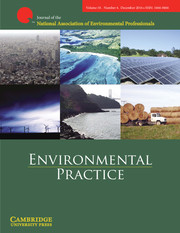Article contents
New Directions in the Use of Remotely Sensed Data for Cumulative Impact Assessment
Published online by Cambridge University Press: 16 August 2005
Extract
\cf1\f1 Consideration of cumulative effects as part of the environmentalimpact assessment process is seen as an essential element toensure a complete determination of impact significance. Theseeffects, defined as the incremental impact of an action whenadded to other past, present, and future activities, often resultfrom individually minor but collectively significant actions takingplace over a period of time. While conceptually appealing,the analysis of cumulative impacts has been frustrated by theabsence of tractable methodologies to facilitate their identificationand inclusion in more comprehensive environmental impactassessments. In this article the potential role of remotelysensed data is discussed and a scoping methodology based onthe use of remotely sensed data is presented. For over threedecades remote sensing has enabled the collection of detailedenvironmental data in a systematic and reliable manner. Themethod introduced in this article utilizes the ability to transformremotely sensed data into landscape indicators that can beemployed to summarize the status of the environmental systemand detect changed conditions over time. Through this procedurethe pattern of cumulative effects on critical environmentalindicators can be observed and the contribution of new actionscan be more easily discerned. The procedure outlined alsosupports the implementation of satellite-based monitoring touncover trends within a specified planning region. A demonstrationof this scoping methodology illustrates that even over acomparatively short time-horizon, remotely sensed data canprovide sufficient information to help identify the significant issuessurrounding cumulative change.\cf0\f0
Information
- Type
- ENVIRONMENTAL REVIEW
- Information
- Copyright
- © 2002 National Association for Environmental Professionals
- 5
- Cited by

